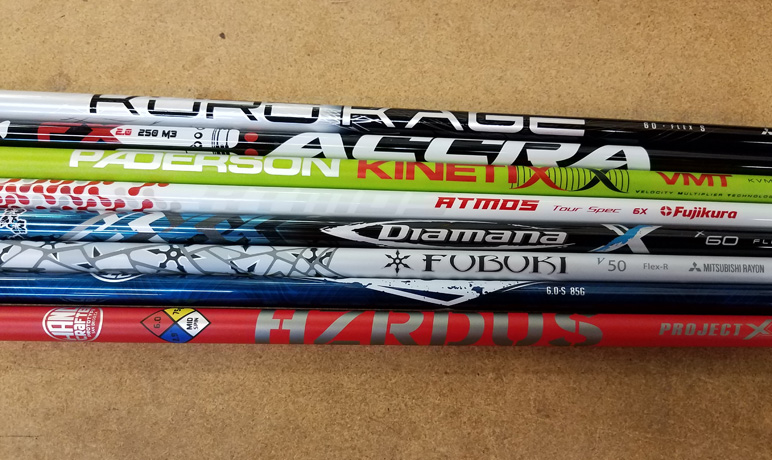How To Pick The Right Shaft For Your Driver

Choosing the Right Shaft for Your Driver: Unlocking Your Golfing Potential
In the game of golf, every swing counts. As a golfer, you strive for consistency, accuracy, and optimal performance on the course. One crucial element that can significantly impact your game is selecting the right shaft for your driver. The golf shaft, often referred to as the engine of your club, plays a pivotal role in determining the trajectory, distance, and control of your shots. It’s not just about swinging harder or having the latest technology; it’s about finding the perfect match between your swing characteristics and the characteristics of the shaft.
But with a plethora of options available, choosing the right shaft can feel like navigating through a maze. Should you opt for a stiff or regular flex? Is graphite or steel the better choice? What about shaft length, weight, torque, and kick point? These questions can be overwhelming.
In this comprehensive guide, we will demystify the process of selecting the right shaft for your driver. We’ll dive into the intricacies of swing speed, player ability, shaft weight, material, length, torque, kick point, and the importance of seeking professional guidance through custom fitting. By understanding these key factors and considering your unique attributes, you’ll be equipped with the knowledge to make an informed decision and unlock your golfing potential. So let’s embark on this journey together and discover the perfect shaft that will elevate your game to new heights.

Understanding the Basics of Golf Shafts
Before delving into the intricacies of selecting a shaft, it’s essential to grasp the fundamental concepts related to golf shafts. Let’s start by exploring what a golf shaft is and how it contributes to your golf swing.
What is a Golf Shaft and How Does It Contribute to the Golf Swing?
The golf shaft is the long, tubular component that connects the clubhead to the grip. It acts as the engine of your golf club, transmitting the energy generated by your swing to the ball. The characteristics of the shaft, such as flex, weight, material, and length, influence how the clubhead behaves during the swing and impact.
Exploring the Different Components of a Golf Shaft
A golf shaft consists of several components that work together to provide stability, control, and power. Understanding these components will help you make better-informed decisions when choosing a shaft for your driver.
| Component | Description |
|---|---|
| Shaft Tip | The top end of the shaft that connects to the clubhead |
| Butt End | The bottom end of the shaft where the grip is attached |
| Shaft Flex | The measure of how much a shaft bends during the swing |
| Shaft Weight | The mass of the shaft, measured in grams |
| Shaft Material | The material used to construct the shaft, such as steel or graphite |
| Kick Point | The point along the shaft where it flexes the most |
| Torque | The degree to which the shaft twists during the swing |
The Role of Flex in Determining the Behavior of the Shaft
Shaft flex is a crucial factor in selecting the right shaft for your driver. It refers to how much a shaft bends during the golf swing, affecting the timing, accuracy, and trajectory of your shots. Let’s delve deeper into the concept of shaft flex and its impact on shot trajectory.
Understanding the Concept of Shaft Flex and Its Impact on Shot Trajectory
Shaft flex is classified into different categories, including regular, stiff, and extra stiff. The flex rating determines the amount of bend in the shaft when subjected to the forces of the swing. Each flex has its own characteristics and is suitable for different swing speeds and player abilities.
- Regular Flex: Designed for golfers with slower swing speeds, regular flex shafts provide more flex, allowing the clubhead to whip through the ball and generate more distance. They are also more forgiving, helping golfers achieve straighter shots.
- Stiff Flex: Golfers with faster swing speeds benefit from stiff flex shafts, which provide less flex during the swing. Stiff shafts offer more control and accuracy, enabling players to shape their shots and optimize performance.
- Extra Stiff Flex: Extra stiff flex shafts are reserved for players with exceptionally high swing speeds. These shafts offer the least amount of flex, delivering maximum control and precision.
By considering your swing speed and the corresponding flex, you can ensure that the shaft complements your swing characteristics, optimizing distance, control and consistency. It’s crucial to match your swing speed with the appropriate shaft flex to achieve the desired shot trajectory and maximize your performance on the course.
Assessing Swing Speed and Tempo
To make an informed decision about the right shaft for your driver, it’s essential to understand your swing speed and tempo. Let’s explore the importance of these factors and how they influence your shaft selection.
Importance of Understanding Your Swing Speed and Tempo
Your swing speed is a key determinant of the shaft flex that suits your game. It represents the velocity at which your clubhead travels during the downswing and impact. Knowing your swing speed helps you narrow down the options and choose a shaft that optimizes your performance.
In addition to swing speed, swing tempo plays a vital role in selecting the right shaft. Swing tempo refers to the pace and rhythm of your swing, whether it’s smooth or aggressive. Understanding your tempo assists in finding a shaft that complements your swing characteristics, enhancing consistency and control.
How to Measure Swing Speed Accurately
Measuring your swing speed accurately is essential for proper shaft selection. Here are a few methods you can use to measure your swing speed:
- Launch Monitor: Utilizing a launch monitor, such as Trackman or Flightscope, provides accurate data on clubhead speed. These devices use advanced technology to track the speed of your swing and provide detailed analysis.
- Golf Simulator: Playing or practicing on a golf simulator equipped with swing analysis capabilities can provide valuable information about your swing speed. Simulators often calculate clubhead speed as part of their data collection process.
- Professional Club Fitting: Seeking the expertise of a professional club fitter is an excellent way to determine your swing speed accurately. Club fitters have access to specialized equipment and knowledge to analyze your swing and measure your clubhead speed precisely.
By obtaining an accurate measurement of your swing speed, you can make informed decisions when selecting a shaft that matches your unique swing characteristics.
Analyzing Swing Tempo and Its Influence on Shaft Selection
Once you have determined your swing speed, it’s equally important to analyze your swing tempo. Swing tempo refers to the timing and rhythm of your swing, and it can be categorized as smooth, moderate, or aggressive.
- Smooth Tempo: Golfers with a smooth tempo have a more relaxed and effortless swing. They maintain a consistent rhythm throughout the swing, emphasizing fluid motion. Golfers with a smooth tempo typically benefit from shafts that offer more flex, helping generate distance and accuracy.
- Moderate Tempo: Golfers with a moderate tempo have a balanced swing rhythm, neither too slow nor too fast. They tend to have a versatile swing style that can adapt to a wide range of shaft flex options. Moderate tempo players have the flexibility to experiment with different shaft flexes based on their specific preferences.
- Aggressive Tempo: Golfers with an aggressive tempo have a faster and more forceful swing. They generate higher clubhead speeds through an explosive downswing. Golfers with an aggressive tempo often benefit from stiffer shafts, as these provide the necessary stability and control to harness the power of their swing.
Considering your swing tempo alongside your swing speed allows you to find a shaft that matches your unique swing characteristics, promoting consistency and improving your overall performance on the course.
Considerations Based on Player Ability and Experience
When selecting a shaft for your driver, it’s essential to consider your skill level and playing experience. Different shaft characteristics cater to players of varying abilities. Let’s explore the considerations based on player ability and experience to help you make an informed decision.
Determining Your Skill Level as a Golfer
To begin, it’s crucial to assess your skill level as a golfer. Skill levels can be broadly categorized as beginners, intermediate players, and advanced players. Understanding your skill level allows you to align your shaft selection with your current abilities and goals.
Beginners: Recommending Forgiving and Lightweight Shafts
If you’re a beginner golfer, it’s important to prioritize forgiveness and ease of use when choosing a shaft for your driver. Here are some considerations for beginners:
- Flexibility: Opt for a shaft with a regular or senior flex. These flex options provide more forgiveness and help generate distance even with slower swing speeds.
- Lightweight Shafts: Choose a lightweight shaft that allows you to swing the club comfortably and with less effort. Lighter shafts can help beginners maintain better control and consistency.
- Graphite Shafts: Consider graphite shafts as they are generally lighter and more forgiving than steel shafts. Graphite shafts can assist beginners in generating more clubhead speed and distance.
- Larger Sweet Spot: Look for drivers with larger clubhead sizes and forgiving faces. These features can help minimize the impact of off-center hits, providing more forgiveness and enhancing your confidence.
Remember, as a beginner, focus on developing your swing mechanics and consistency. Choosing a forgiving and lightweight shaft can greatly assist you in building a solid foundation for your game.
Intermediate Players: Exploring Options for Customization and Fine-Tuning
Intermediate players have gained some experience and are looking to refine their skills and improve their performance. Consider the following aspects when selecting a shaft:
- Swing Speed and Flex: Assess your swing speed to determine the appropriate flex for your shaft. Consider a slightly stiffer flex if your swing speed has increased since you started playing.
- Custom Fitting: Opt for a custom fitting session with a professional club fitter. They can analyze your swing dynamics, collect data, and recommend shaft options tailored to your swing characteristics and preferences.
- Adjustability Features: Explore drivers with adjustability features that allow you to fine-tune loft, lie angle, and face angle. These adjustments can optimize your launch conditions and ball flight, improving both distance and accuracy.
- Shaft Weight and Material: Consider the weight and material of the shaft. Intermediate players may have the opportunity to experiment with different shaft weights and materials to find the optimal balance of control and distance.
As an intermediate player, you are likely seeking more customization options and fine-tuning opportunities to optimize your performance on the course. A professional club fitting can provide valuable insights and recommendations specific to your game.
Advanced Players: Considering Shafts Tailored to Specific Preferences and Shot Shaping Capabilities
Advanced players have honed their skills and are often seeking to fine-tune their performance even further. Here are some considerations for advanced players when choosing a shaft for their driver:
- Shaft Profile: Consider a shaft with a specific profile that matches your desired shot shape. Some shafts are designed to promote a draw or a fade, allowing you to optimize your ball flight and shot shaping capabilities.
- Customized Specifications: Work closely with a professional club fitter to customize various aspects of your shaft, such as weight, flex, kick point, and torque. These fine-tuned specifications can help you achieve optimal launch conditions and shot control.
- Premium Shaft Materials: Advanced players may explore high-performance shaft materials, such as high modulus graphite or advanced composite materials. These materials offer enhanced stability, feel, and control for players who demand the utmost performance from their equipment.
- Player Feedback: Seek feedback from other advanced players or professionals who have similar swing characteristics or playing styles. Their insights and experiences can provide valuable guidance in selecting the right shaft for your driver.
As an advanced player, your focus is on maximizing your performance and fine-tuning your game to achieve specific shot outcomes. Customization, premium materials, and seeking input from fellow golfers can help you find a shaft that aligns with your individual preferences and enhances your shot-making abilities.
Analyzing Shaft Weight and Material
The weight and material of the shaft significantly influence the performance and feel of your driver. Let’s delve into the considerations related to shaft weight and material to help you make an informed decision.
Understanding the Impact of Shaft Weight on Swing Mechanics
The weight of the shaft can affect your swing mechanics and the overall performance of your driver. Here are some key points to consider:
- Lighter Shafts: Lighter shafts can increase clubhead speed and promote greater distance. They are often preferred by players with slower swing speeds, seniors, and those looking for added maneuverability.
- Heavier Shafts: Heavier shafts provide more stability and control. They can be beneficial for players with faster swing speeds and those seeking enhanced accuracy and consistency.
Finding the right balance between weight and control is crucial. It’s recommended to experiment with different shaft weights to determine the optimal combination that suits your swing and playing style.
Comparing the Benefits and Drawbacks of Different Shaft Materials
Golf shafts are commonly constructed using steel, graphite, or other composite materials. Each material has its own characteristics, offering unique benefits and drawbacks. Let’s explore the different shaft materials:
- Steel Shafts: Steel shafts are known for their durability, consistency, and control. They provide a solid feel and are often preferred by players who prioritize accuracy and a lower trajectory. However, they tend to be heavier compared to graphite shafts.
- Graphite Shafts: Graphite shafts are lighter, which can increase swing speed and distance. They are popular among players seeking enhanced forgiveness, feel, and a higher launch. Graphite shafts can help players with slower swing speeds generate more clubhead speed, resulting in increased distance. However, they may sacrifice a bit of control compared to steel shafts.
- Other Composite Materials: In recent years, various composite materials have been introduced in shaft manufacturing, offering unique properties such as improved stability, feel, and vibration dampening. These materials allow for more design flexibility and can cater to specific player preferences.
When choosing between steel and graphite shafts or exploring composite materials, consider factors such as swing speed, desired performance characteristics, and personal preference. It’s recommended to test different materials to determine which one provides the optimal combination of feel, control, and distance for your game.
Determining Shaft Length
The length of the shaft plays a crucial role in your swing mechanics, consistency, and overall performance. Let’s explore the considerations related to determining the appropriate shaft length for your driver.
Exploring the Role of Shaft Length in the Golf Swing
The length of the shaft directly influences the clubhead’s speed, swing plane, and the distance you can achieve. Here are key points to consider:
- Standard Length: Drivers typically come with a standard shaft length. This length suits the majority of golfers, providing a balance between control and distance. It’s recommended for players with average height and those comfortable with the standard specifications.
- Longer Shafts: Longer shafts can potentially generate more clubhead speed and distance. They offer an extended swing arc, which can be advantageous for players with a smooth tempo and those seeking additional length off the tee. However, longer shafts may also be more challenging to control and could lead to less accuracy.
- Shorter Shafts: Shorter shafts offer increased control and accuracy. They are suitable for players with faster swing speeds or those who struggle with consistency. Shorter shafts can provide a tighter dispersion pattern and help players find the fairway more consistently.
It’s important to note that altering the shaft length can impact the swing weight and balance of the club. It’s advisable to consult with a professional club fitter to determine the optimal shaft length for your driver. They can assess your swing dynamics, consider your physical measurements, and recommend the appropriate shaft length to optimize your performance on the course.
Assessing Shaft Torque and Kick Point
Shaft torque and kick point are two critical factors that influence the behavior of the shaft during the swing. Understanding their impact can help you choose a shaft that suits your swing characteristics and desired shot trajectory.
Understanding the Concepts of Torque and Kick Point
- Shaft Torque: Torque refers to the degree to which the shaft twists during the swing. It affects the timing and release of the clubhead, ultimately influencing shot dispersion and control. Shafts with lower torque provide greater stability and control, while higher torque shafts may offer more feel and the potential for increased shot shaping capabilities.
- Kick Point: The kick point, also known as the bend point, is the location along the shaft where it flexes the most during the swing. It influences the launch angle and trajectory of your shots. A higher kick point promotes a lower ball flight, while a lower kick point helps launch the ball higher.
Choosing the Appropriate Torque and Kick Point for Your Swing Characteristics
The optimal torque and kick point for your driver shaft depend on your swing characteristics and desired shot outcomes. Here are some considerations:
- Swing Tempo and Torque: Players with a smoother swing tempo often benefit from lower torque shafts as they provide greater stability and control. Players with an aggressive tempo might prefer shafts with higher torque for enhanced feel and shot shaping capabilities.
- Swing Speed and Kick Point: Players with slower swing speeds may benefit from a lower kick point, as it helps launch the ball higher and maximize carry distance. Players with faster swing speeds might prefer a higher kick point for a more penetrating ball flight.
Finding the right balance between torque and kick point involves understanding your swing dynamics, personal preferences, and desired shot outcomes. Experimenting with different combinations and seeking professional guidance can help you identify the optimal torque and kick point for your game.
Seeking Professional Guidance and Custom Fitting
While this guide provides valuable information for selecting the right shaft for your driver, it’s important to highlight the significance of seeking professional guidance through custom fitting. A professional club fitting session can provide precise measurements, data-driven analysis, and personalized recommendations to optimize your equipment for your unique swing characteristics. Here are some reasons to consider professional guidance:
- Individualized Assessment: A club fitter will evaluate your swing, gather data, and analyze factors such as swing speed, tempo, launch conditions, and shot dispersion. They can recommend shaft options that align with your specific needs and goals.
- Shaft Testing and Comparison: Professional club fitters have access to a wide range of shaft options for testing and comparison. They can help you understand the nuances of different shafts, allowing you to make informed decisions based on performance and feel.
- Customization Opportunities: Custom fitting allows for adjustments in various aspects, including shaft flex, weight, length, and grip size. These customized specifications can greatly enhance your comfort, consistency, and overall performance.
- Expertise and Experience: Professional club fitters have extensive knowledge and experience working with different golfers and their unique requirements. They stay updated on the latest shaft technologies and trends, ensuring you receive expert advice and recommendations.
By investing in a professional club fitting session, you can have confidence that you’re selecting the right shaft for your driver based on accurate data and expert guidance tailored to your individual attributes.
Testing and Experimentation
Once you’ve gathered information about shaft flex, weight, material, length, torque, kick point, and sought professional guidance, it’s time to put the knowledge into action through testing and experimentation. Here’s how you can approach this stage:
- On-Course Testing: Take the shaft options that align with your preferences and recommendations from the professional club fitting session out onto the golf course. Hit shots with each shaft, paying attention to the feel, control, distance, and shot dispersion. Assess how each shaft performs in real playing conditions and take note of your observations.
- Launch Monitor Analysis: Utilize a launch monitor during your testing sessions to gather quantitative data on key metrics such as clubhead speed, ball speed, launch angle, spin rate, and shot dispersion. This data provides objective feedback on how each shaft performs and can assist in making data-driven decisions.
- Seek Feedback: Share your findings and experiences with fellow golfers, friends, or instructors who have knowledge in equipment selection. Their insights and feedback can provide valuable perspectives and help you gain further clarity in choosing the right shaft for your driver.
- Make Informed Decisions: Based on your on-course testing, launch monitor analysis, and feedback, evaluate the performance of each shaft option. Consider factors such as consistency, accuracy, distance, and overall feel. Ultimately, select the shaft that aligns with your preferences and enhances your game the most.
Remember, testing and experimentation are crucial to finding the perfect shaft for your driver. Everyone’s swing and preferences are unique, so taking the time to assess different options will help you make an informed decision tailored to your game.
Conclusion
Selecting the right shaft for your driver is a vital step in optimizing your golf game. By considering factors such as swing speed, player ability, shaft weight, material, length, torque, kick point, and seeking professional guidance, you can find a shaft that complements your swing characteristics, enhances your control, and maximizes your distance.
Investing time and effort in understanding your swing dynamics, testing various options, and seeking professional advice through custom fitting will ensure that you make an informed decision. Remember, the right shaft can make a significant difference in your performance on the course, so choose wisely and enjoy the benefits of a well-suited shaft for your driver.




